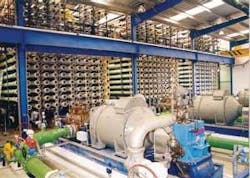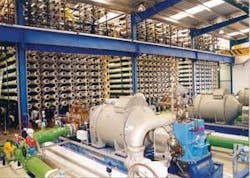Spanish Companies Focus on Desalination Technology
As communities in developing countries seek ecologically sound, sustainable solutions to help them grow and thrive, nothing is more fundamental than securing reliable sources of clean drinking water. Thanks to technological advances, desalination has become an economically viable way to supply this water in some regions.
Today, there are over 15,000 desalination plants in the world. Saudi Arabia, the United Arab Emirates and Kuwait, because of their limited water supplies and tremendous energy reserves, are the world’s leading users of desalination technology. But desalination is gaining popularity also in the West - and Spanish companies are leading the charge.
Spain’s Desalination History
Spain’s involvement with desalination spans several decades. The nation was the first European country to install a desalination plant in 1964, on the island of Lanzarote in the Canary Islands. In those years, the government saw an opportunity to boost economic activity through tourism to the sun-drenched Canary Islands. Because of insufficient natural water there to make this vision a reality, a desalination plant was built to lay the groundwork for tourist-related growth.
The plant used the same technology in use in the Middle East - the vaporization of water via multi-stage flash distillation, a process by which boiling or evaporating the water separates it from salts, but also uses tremendous amounts of energy. By the 1970s, the Spanish government started switching processes and began using the then-novel reverse osmosis (RO) technology for newer plants.
In RO technology, seawater is pushed through a membrane, leaving higher concentrated solutions of dissolved solids (the salt) behind. Though more efficient than vaporization or distillation, these plants still demanded a high energy output due to pumping requirements. Over time, engineers developed recovery systems to take advantage of the high pressure of waste brine left over, significantly dropping energy needs for the process. While it once took about 12 kilowatt-hours (kWhrs) of energy to produce one cubic meter of freshwater using RO technology, it now takes just 3-4 kWhrs. Meanwhile, the cost of the membranes used in RO technology also has dropped about 50%.
At the same time, conventional sources of freshwater have become more costly in recent years. And the Canary Islands haven’t been the only areas of Spain affected by drought and inadequate access to water. It also has long been a problem in the coast along the Mediterranean south. There, the favorable climate and long hours of sunshine have created a very productive agricultural industry and a haven for tourists which, in turn, have exacerbated the region’s natural water shortage problems.
Spain Embraces Desalination
To supply this parched region with water, the Spanish government has drawn up a plan that supplies water to the south without taking it from the north, mainly through the building of 20 new desalination plants along the Mediterranean coast where the needs are greatest.
These plants are expected to be completed by the end of 2008. They’ll join the more than 700 plants already operating in Spain - plants that produce enough water each day for eight million people. During the nation’s wholehearted embrace of desalination technology, Spain’s production of desalinated water doubled from 2000 to 2004 alone - and is predicted to double again within the next five years.
Spain’s experience with desalination has made the country a major player in the international desalination market. Today, Spanish companies make up the largest percentage of competitors for the design, engineering, construction and operation of new desalination plants around the world.
For instance, Algeria has commissioned seven desalination plants - five of which will be built entirely by Spanish companies. The Spanish company Inima is currently building its first U.S. plant near Boston as well as a plant in Mexico’s resort town of Los Cabos in Baja California. And the Spanish company Befesa is now building India’s first desalination plant in Chennai. Meanwhile, Spanish companies are also in competition for bids in Libya, China and Israel.
In the Middle East, most plants in the past have used vaporization technologies, not the energy-efficient RO plants at which Spanish companies excel. But many new plants in the region are now being installed with RO technologies as the price of oil continues to rise. Spanish companies already are working in Saudi Arabia, Oman and the United Arab Emirates, and have plans to expand into this market.
Drinking Clean - and Going Green
When new desalination plants are proposed, environmental concerns are often raised, particularly surrounding disposal of the residual brine, which has twice the salinity of seawater and is typically returned to the sea. But the area’s sea conditions and the local marine life’s resistance to salinity are studied before a plant is opened. The outflow is typically piped far enough from sensitive species that the water quickly disperses into the surroundings - and there has yet to be a documented case of serious negative effects from brine disposal.
In truth, desalination has been selected in many environments, including Spain and Australia, because it preserves natural resources that would have been depleted had the alternative, water transmission, been chosen. And scientists are currently working to make desalination even more environment-friendly by investigating how to produce freshwater from saltwater without using fossil fuels.
At the Canary Islands Institute of Technology (ITC), researchers are testing renewable-energy solutions in conditions similar to those of many developing countries. Using solar and wind generators, which are hooked up to a utility grid, they’re able to offset the power demands of the desalination plant. On the Canary island of El Hierro, which has 10,000 inhabitants, ITC is involved in a project that will eventually serve 100% of the island’s energy needs through renewable energy, and will also power a desalination plant to supply all the island’s drinking water and irrigation needs.
Already, four small desalination plants using renewable energy are being tested outside the Canary Islands among a population of African fishermen living within the boundaries of a national park called Banc D’Arguin in Mauritania. Once diesel-run, the plants are being converted to run on a hybrid of wind, solar and diesel power.
SWRO aids drought defense
Director of Andalucía’s regional water authority, Cuenca Mediterránea Andaluza, Antonio Rodríguez Leal said, at a March conference on tourism and sustainability, that efforts of the national seawater desalination programme offer a bulwark against drought, reported Spain’s EFE news agency. He noted area reservoirs are at 36.3% capacity, despite saving 60 hm3 of water since a November 2005 drought decree.
Meanwhile, Veolia Water and a group of Spanish companies - Sando, Inypsa and Montajes Electricos Crescencio Perez - won a ?128 million design, construction and 15-year O&M contract for an 80,000-m3/d SWRO plant at Campo de Dalias in the province of Almería. Set for delivery in summer 2009, it will be Spain’s fourth biggest seawater desalination unit.
Likewise, a consortium of Grupo ACS, Grupo Cobra and Tedagua building a 64,000-m3/d SWRO plant for Ente Publico del Agua in Escombreras, Spain, recently chose Nitto Denko unit Hydranautics to supply 3,150 SWC4+ and 1,890 SWC5 membrane elements for the 25-year build-own-operate project, set for delivery this spring.
Conclusion
These new approaches to using renewable energy in tandem with desalination still have many hurdles to overcome, including maintenance needs that make them difficult to apply in remote Third World locations. But desalination alone, even when not powered by renewable energy, is already a viable solution for one of the world’s most critical environmental concerns. According to the United Nations Environmental Programme, hundreds of scientists around the world see water shortages as one of the top concerns for the new millennium. By using their expertise in desalination to dip into the nearly limitless seas, Spanish companies are poised to help avert this looming water crisis by supplying clean, fresh drinking water to millions more people around the world.
Author’s Note:
Enrique Alejo is the Economic and Commercial Counselor of Spain for the U.S. Midwest in Chicago, Illinois, USA. Before this, he was appointed to various posts in economic and commercial fields with the Spanish administration, including Director-General of Trade and Investments in the Ministry of Economy. In this position, he held a portfolio of responsibilities ranging from management of commercial policies to international assistance programs.


